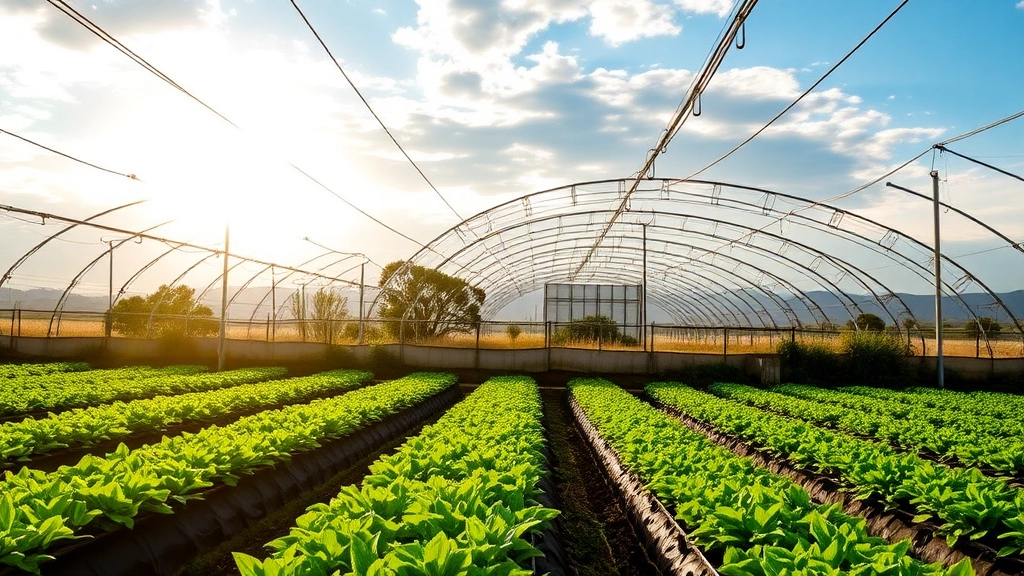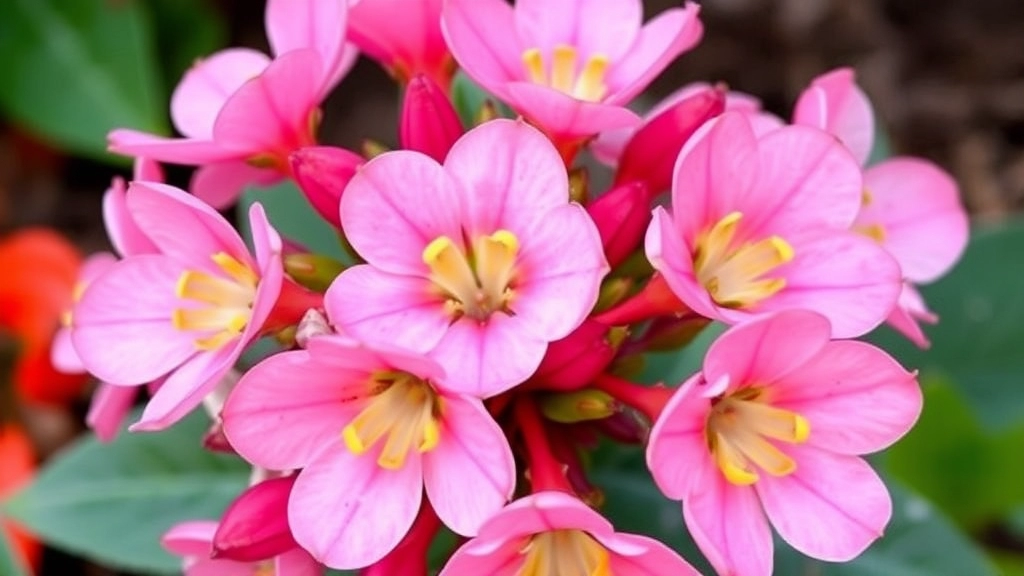Kalanchoe Flowering Season in Australia
When it comes to the Kalanchoe flowering season in Australia, timing and care are key. As an avid gardener, I’ve found that these vibrant blooms can transform any space with their bright colours and long-lasting flowers. Whether you’re a seasoned plant enthusiast or just starting out, understanding the blooming cycle of Kalanchoe in the Australian climate is crucial for a thriving garden.
Timing of the Flowering Season
In Australia, the Kalanchoe flowering season typically spans from late winter to early spring. This period is perfect for enjoying their stunning display.
Care Tips for Kalanchoe
- Provide plenty of indirect sunlight.
- Be mindful of watering habits.
- Overwatering can be detrimental, so it’s best to let the soil dry out between waterings.
With the right care, your Kalanchoe will reward you with a spectacular array of flowers.
Overview of Kalanchoe Plants
Have you ever wondered why Kalanchoe plants have become a popular choice for both indoor and outdoor gardens in Australia?
These vibrant succulents are not only visually appealing but also remarkably resilient.
Kalanchoe, belonging to the Crassulaceae family, is known for its fleshy leaves and stunning clusters of flowers.
With a variety of species available, these plants can thrive in diverse conditions, making them an ideal choice for Australian gardeners.
Key Characteristics of Kalanchoe
- Succulent Nature: Kalanchoe plants store water in their leaves, allowing them to survive in arid conditions.
- Diverse Species: From the popular Kalanchoe blossfeldiana to the unique Kalanchoe tomentosa, each species offers distinct colours and shapes.
- Flowering Abilities: Known for their vibrant blooms, Kalanchoe can add a splash of colour to any garden or home setting.
Kalanchoe plants are not just about aesthetics; they also provide numerous benefits.
Optimal Growing Conditions in Australia

So, you’re keen on growing Kalanchoe in Australia, right?
You might be wondering what conditions these vibrant plants thrive in.
Well, let’s dive in!
Sunlight Needs
Kalanchoe loves the sun.
Aim for at least 6 hours of bright, indirect sunlight each day.
If you can provide a spot that gets morning sun and some afternoon shade, you’re golden.
Temperature Preferences
These beauties prefer a warm climate.
Keep them in temperatures ranging from 15°C to 25°C.
Watch out for frost, though! Kalanchoe isn’t a fan of the cold.
Soil Requirements
A well-draining soil mix is essential.
You can use a cactus or succulent mix or make your own by blending:
- 1 part potting soil
- 1 part sand
- 1 part perlite
This mix ensures your Kalanchoe won’t sit in water, which can lead to root rot.
Watering Wisely
Less is more when it comes to watering.
Allow the soil to dry out completely between waterings.
In summer, you might need to water weekly, but in winter, cut back to every few weeks.
Humidity Levels
Kalanchoe isn’t picky about humidity.
They prefer a dry environment, so don’t stress too much if your home isn’t humid.
Fertilizing
Feed your Kalanchoe with a balanced, water-soluble fertilizer every 4-6 weeks during the growing season.
This will help them flourish and produce those stunning blooms.
Potting and Repotting
Choose pots with drainage holes to prevent waterlogging.
Repot every couple of years to refresh the soil and give the roots some room to grow.
Seasonal Flowering Patterns
Are you curious about when your Kalanchoe plants will bloom? Understanding their seasonal flowering patterns can help you anticipate their vibrant displays and plan your care accordingly.
Kalanchoe plants are known for their stunning clusters of flowers, which typically bloom during specific seasons. In Australia, the flowering period can vary based on the local climate and conditions. Here’s what you need to know:
- Spring Blooming: Most Kalanchoe varieties thrive in spring, producing an abundance of flowers. This is the prime time to enjoy their beauty.
- Summer Resilience: While flowering may reduce in the heat of summer, the plants remain lush and green. They often take a break during this time to conserve energy.
- Autumn Revival: As temperatures cool, many Kalanchoe species will start to flower again. This can lead to a second wave of blooms, particularly in regions with milder autumns.
- Winter Dormancy: In colder areas, Kalanchoe may enter a dormant phase during winter. While they may not produce flowers, their foliage remains attractive.
To maximise your Kalanchoe’s blooming potential, consider these tips:
- Light Exposure: Ensure they receive plenty of bright, indirect sunlight, especially during the flowering season.
- Watering Schedule: Maintain a consistent watering routine, allowing the soil to dry out between waterings. This helps promote healthy blooms.
- Fertilisation: Use a balanced fertiliser during the growing season to encourage flowering.
Understanding these seasonal patterns not only enhances your gardening experience but also helps you appreciate the beauty of Kalanchoe throughout the year. For more detailed care instructions, check out our complete care guide for Kalanchoe orange plants and learn about the different types of Kalanchoe plants you can grow.
Regional Variations in Flowering

Understanding how regional differences affect the flowering patterns of Kalanchoe plants is essential for any gardener in Australia.
Why Do Flowering Patterns Vary?
The flowering of Kalanchoe can significantly differ based on climate, soil type, and local conditions.
- Climate Zones: Australia has a range of climate zones, from tropical in the north to temperate in the south.
- Soil Quality: Well-draining soil is crucial, but its composition can vary widely across regions, affecting growth.
Northern Australia
In tropical regions, Kalanchoe tends to bloom more frequently throughout the year.
- Longer Growing Seasons: The warm temperatures encourage continuous flowering.
- Humidity Levels: Higher humidity can enhance the plant’s growth but may also lead to fungal issues.
Central Australia
In arid zones, Kalanchoe may face challenges due to extreme temperatures and limited water availability.
- Shorter Blooming Periods: Flowering may be concentrated in the cooler months.
- Watering Needs: Regular watering is essential, but care must be taken to prevent root rot.
Southern Australia
In temperate areas, the flowering season is more defined, typically occurring in spring and summer.
- Cooler Winters: The dormancy period allows the plant to conserve energy.
- Frost Risks: Protecting Kalanchoe from frost is crucial for maintaining health and vitality.
Care Tips for Prolonged Blooming
As we explore how to enhance the beauty of Kalanchoe plants, it’s essential to understand the specific care they require for prolonged blooming. Many plant enthusiasts often worry about their Kalanchoe losing its vibrant flowers too soon.
To ensure your Kalanchoe thrives and continues to bloom beautifully, consider the following tips:
- Light Requirements:
- Kalanchoe loves bright, indirect sunlight.
- Place your plant near a window but avoid harsh afternoon sun to prevent leaf scorch.
- Watering:
- Allow the soil to dry out completely between waterings.
- Overwatering can lead to root rot, so it’s better to err on the side of caution.
- Fertilisation:
- Feed your Kalanchoe with a balanced, water-soluble fertiliser every four to six weeks during the growing season.
- This will provide the necessary nutrients for vibrant blooms.
- Temperature and Humidity:
- Kalanchoe prefers temperatures between 15-25°C.
- Ensure good air circulation but avoid drafts.
- Pruning:
- After flowering, prune back the spent blooms and any leggy growth.
- This encourages new growth and more blooms in the future.
- Repotting:
- Every couple of years, consider repotting your Kalanchoe into fresh soil.
- This refreshes nutrients and promotes healthy growth.
By following these care tips, you can enjoy a longer blooming period for your Kalanchoe, creating a stunning display in your home or garden. For more detailed information, you might find our Flaming Katy Kalanchoe Blossfeldiana Care Guide helpful. Additionally, if you encounter any issues with yellowing leaves, our article on Why Kalanchoe Bottom Leaves Turn Yellow offers valuable solutions.
Common Issues and Solutions

So, you’ve got your Kalanchoe plants thriving, but what happens when things start to go sideways?
Let’s dive into some common issues you might face and how to tackle them like a pro.
1. Leaf Dropping
- Why It Happens: Usually due to overwatering or sudden temperature changes.
- Solution:
- Check the soil moisture—if it’s soggy, hold off on watering.
- Keep your Kalanchoe in a stable environment, away from drafts.
2. Pest Problems
- Common Pests: Mealybugs and aphids can be a real nuisance.
- Solution:
- Use a cotton swab dipped in rubbing alcohol to wipe them off.
- For a bigger infestation, a gentle insecticidal soap can work wonders.
3. Poor Flowering
- Why It Happens: It might be due to insufficient light or nutrient deficiencies.
- Solution:
- Ensure your Kalanchoe gets at least 6 hours of bright, indirect sunlight.
- A balanced fertiliser during the growing season can help boost blooms.
4. Fungal Issues
- Signs to Look For: Dark spots on leaves or a white, powdery substance.
- Solution:
- Improve air circulation around the plant.
- Use a fungicide if the problem persists, but make sure to follow the instructions carefully.
5. Stunted Growth
- Why It Happens: Often due to root-bound conditions or lack of nutrients.
- Solution:
- Repot your Kalanchoe into a larger pot if you notice roots coming out of the drainage holes.
- Regularly feed it with a diluted fertiliser during the growing season.
As we explore the vibrant world of Kalanchoe plants, it’s important to consider how they can thrive alongside other flora. Choosing the right companion plants can enhance their beauty and overall health.
Benefits of Growing Kalanchoe in Australia
So, why should you consider adding Kalanchoe to your garden or home?
Let’s dive into the perks of growing these vibrant plants in Australia.
1. Easy Care
Kalanchoe are pretty low-maintenance.
- Drought-resistant: They thrive on minimal watering.
- Pest-resistant: Not many bugs bother them, which is a win for any gardener.
2. Stunning Blooms
If you’re after colour, Kalanchoe delivers.
- Long-lasting flowers: Their blooms can last for weeks, brightening up any space.
- Variety of colours: From reds to yellows, there’s a shade for every style.
3. Air Purification
Did you know Kalanchoe can help clean your indoor air?
- Natural air filters: They absorb toxins and release oxygen, making your home feel fresher.
4. Versatile Use
Kalanchoe isn’t just for gardens.
- Indoor plants: Perfect for brightening up your living room or office.
- Gifts: A lovely choice for housewarming gifts or special occasions.
5. Connection to Nature
Growing your own plants can be therapeutic.
- Stress relief: Tending to Kalanchoe can help reduce anxiety and improve mood.
- Mindfulness: Engaging with nature brings a sense of peace and connection.
6. Eco-Friendly Choice
By growing Kalanchoe, you’re contributing to a healthier environment.
- Sustainable gardening: They require less water and care, making them eco-friendly.
- Biodiversity: Supporting local flora helps maintain local ecosystems.
For more detailed care tips and information on various Kalanchoe species, check out our Complete Guide to Kalanchoe Plant Care. If you’re interested in a specific variety, such as the Kalanchoe Paddle Plant, we have detailed guides to help you grow and care for them effectively.
FAQs on Kalanchoe Flowering Season in Australia
What are the optimal growing conditions for Kalanchoe in Australia?
Kalanchoe thrives in bright, indirect sunlight for at least 6 hours a day, prefers warm temperatures between 15°C to 25°C, and needs well-draining soil. A cactus or succulent mix is ideal, and it’s important to allow the soil to dry out completely between waterings.
How does the flowering season of Kalanchoe vary across different regions of Australia?
In tropical regions of Northern Australia, Kalanchoe tends to bloom more frequently throughout the year due to longer growing seasons and higher humidity levels. In arid zones of Central Australia, flowering is concentrated in cooler months with regular watering needed. In temperate areas of Southern Australia, the flowering season typically occurs in spring and summer, with cooler winters allowing for a dormancy period.
What are common issues faced when growing Kalanchoe and their solutions?
Common issues include leaf dropping due to overwatering or sudden temperature changes, pest problems from mealybugs and aphids, poor flowering due to insufficient light or nutrient deficiencies, fungal issues indicated by dark spots or white powdery substance, and stunted growth often caused by root-bound conditions or lack of nutrients.
How often should I water my Kalanchoe plant?
Watering frequency depends on the season. In summer, you may need to water weekly, but in winter, it’s best to cut back to every few weeks. Always allow the soil to dry out completely between waterings to prevent root rot.
What type of soil is best for Kalanchoe plants?
Kalanchoe requires a well-draining soil mix. A cactus or succulent mix works well, or you can create your own blend using 1 part potting soil, 1 part sand, and 1 part perlite.
How can I improve the flowering of my Kalanchoe?
Ensure your Kalanchoe gets at least 6 hours of bright, indirect sunlight each day and feed it with a balanced, water-soluble fertilizer every 4-6 weeks during the growing season.
What should I do if my Kalanchoe plant has pest problems?
For minor infestations, use a cotton swab dipped in rubbing alcohol to wipe off pests like mealybugs and aphids. For larger infestations, a gentle insecticidal soap can be effective.
How do I prevent fungal issues in my Kalanchoe plant?
Improve air circulation around the plant and use a fungicide if necessary, following the instructions carefully. Look out for signs like dark spots on leaves or a white, powdery substance.
When should I repot my Kalanchoe plant?
Repot your Kalanchoe every couple of years to refresh the soil and give the roots more room to grow. Choose pots with drainage holes to prevent waterlogging.
Can Kalanchoe tolerate frost?
No, Kalanchoe is not frost-tolerant and should be protected from frost to maintain its health and vitality, especially in cooler regions of Southern Australia.
